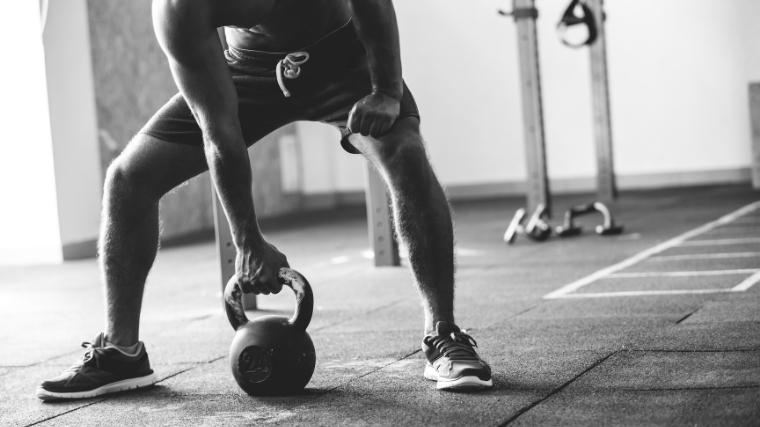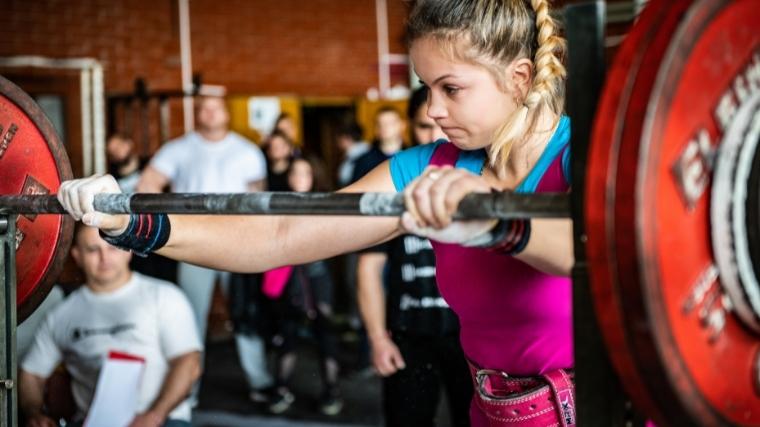If you despise slogs on the treadmill or repetition bouts of biking, then keep reading. If you didn’t know, improving your cardio is heart-healthy and can grant you the conditioning to lift heavier weight for more reps (which equals greater gains). Your cardio doesn’t have to be traditional, but it does have to be effective. Kettlebell flows in particular have some unique benefits that will leave you a stronger, better conditioned, and more versatile athlete.
The unilateral and off-balance nature of the kettlebell — and the many explosive moves you can perform with it — makes the tool uniquely suited to endless kettlebell flow combinations. Even though they’re simple on the surface, kettlebell flows are more hardcore than they sound.

Have you ever performed six explosive kettlebell movements that all only counted as one rep? If you have, read on for how to create your own kettlebell flows so you can keep reaping those benefits. If you haven’t, allow us to convince that the next thing you want to do in the gym is grab a kettlebell and get flowing.
What Is a Kettlebell Flow?
You take one lift and perform it in sequence with two or three (or more) exercises without putting the implement down. For example, a one-handed kettlebell swing might flow into a snatch, which will flow into an overhead squat. Then it’ll come back to center so you can reverse hands and do it all again. You don’t stop moving the whole time, and you don’t put the kettlebell down.
A four-move kettlebell flow might look like this: one rep equals a single-arm kettlebell swing to a clean to a front squat to an overhead press. A three-move kettlebell flow might be: one rep equals one double kettlebell deadlift to a clean to a snatch. Even though it has fewer moves, the second flow would generally be considered more complex. That’s because it involves two kettlebells rather than one (so you’re moving and coordinating more weight) and it involves the kettlebell snatch.
Why Perform a Kettlebell Flow
Whether you’re looking to boost your cardio, gain more muscle endurance, or just generally get stronger, kettlebell flows can help you get there. You’ll move through multiple exercises in just one rep, meaning that you’ll maximize your bang for your buck in a big way.
Don’t love the treadmill? No problem. Since your repetitions will occur without pause or putting the kettlebell down, kettlebell flows will rev up your cardiovascular system. Want to be able to lift heavier weights? Kettlebell flows force you to perfect your form under immense physical strain and tension. This means that when you come back to the barbell, you’ll be able to move more efficiently — and therefore lift more weight.
And, a very significant sidebar — your grip strength will increase as you start adding kettlebell flows to your routine. Since you’ll never put the bell down between complex transitions and lifts, your grip is going to take a beating that will ultimately make it much, much stronger. And yes, that translates into more powerful deadlifts.
How to Do a Kettlebell Flow
Kettlebell flows have a lot of literal moving parts, and they take a bit of discipline to master. But taking the time to learn how to do them is well worth the effort. You can break the process down into a few simple steps.
Step 1: Learn Your Moves
First things first: know your kettlebell moves. Before you attempt any kettlebell flow, make sure you know how to perform each component perfectly. Never quite got the hang of single-arm kettlebell swings? Master them before trying a complex that includes them.
This is especially important during kettlebell flows because even one rep of a flow is extremely taxing. Your heart rate will be up and your entire body will be engaged, so your form can break down easily. This is especially true when doing a complex movement like a snatch or thruster within your flow.
Step 2: Design Your Flow
You want the moves to literally flow into each other. For example, programming a deadlift right before a high pull works well mechanically as the weight travels up from the floor and in a straight line up to face level. A kettlebell swing into an upright row also technically works, but remember that that’s a lot of momentum to stop and your back might not love it. A deadstop kettlebell swing into a row might work better — it’ll still be challenging, but it’ll produce less physical strain on your body.
Think about the movements you want to perform and then order them thoughtfully and sensibly.
Step 3: Practice With Your Body
Once you’ve got these basics down — know all the moves and start with a light weight — get yourself set up for the flow without a kettlebell in hand. You might feel silly, but start drawing those neural pathways for the movement with just your body weight first. The flow will be much easier to master, plus you’ll prime your body as specifically as possible for the moves you’re about to tackle.
Step 4: Select Your Weight
Always select a much lighter weight than you think you’ll need. No matter how much you think you have the sequence in your head — row, then clean, then squat, then press, repeat — it’s always going to take a bit of brainpower to teach your body how to do it smoothly.

[Read More: The Best Bodyweight Exercises, + Workouts and Tips From a CPT]
While you’re ironing out the kinks, you’ll be grateful for a lighter weight. Remember that the lightest lift in your flow limits the weight you use under any circumstances — so even if you can front squat quite a hefty bell, when the flow includes an overhead press, make sure you consider that factor in weight selection.
Step 5: Get To Work
Once you’ve gone through a few weightless reps, ramp up just like you would do with barbell work. Use a very light kettlebell and flow through two or three reps. Stay with that lighter weight if the flow is new to you. Otherwise, rest, select the next weight up, and continue.
In terms of executing the actual flow, a kettlebell flow is pretty much what it says on the tin. Just perform each move in turn. Say the flow is: single-arm kettlebell deadlift into row into clean and press. First set yourself up for a single-arm kettlebell deadlift. Perform that lift. After locking out at the hips, hinge immediately to set yourself up to perform a single-arm kettlebell row.
Once you’ve done that, shift as needed to perform a clean, then explode into a press. All of that constitutes one rep. Then bring the kettlebell back down and return to starting position (with the bell on the ground, ready to deadlift). Make sure that you keep everything even on both sides.
Who Should Perform Kettlebell Flows
Short answer: everyone who physically is able. Long answer: everybody who physically is able. Longer answer: keep reading.
Powerlifters
Powerlifters live and die by the barbell, but kettlebells can be tremendously useful to powerlifters, too. Ironing out muscle asymmetries with kettlebell training can make all the difference when you’re trying to improve one of your big lifts. No one wants one of their arms working harder than the other during their bench press.

Plus, kettlebell flows will kick your butt into being a more well-conditioned athlete. Yes, they’ll help you get stronger, but they’ll also force your cardiovascular capacity to improve. In other words, kettlebell flows can help you avoid collapsing after performing — gasp! — 10 or more reps per set during your hypertrophy blocks with barbells. (And, trust us, if you’ve ever done 20-rep squats, then you know how taxing those sets can be.)
Bodybuilders
Bodybuilders, rejoice — your program can help build strength and change body composition all at the same time when you integrate kettlebell flows. These flows are, by nature, much more energetically demanding than the same moves would be on their own. That’s because you’re moving without pause between different moves. You’ll be upping your muscular endurance, conditioning, and strength all at once — which is definitely a win-win-win for bodybuilders.
Olympic Lifters
Olympic lifters need to have a lot of explosive power to be successful in their programming. But Olympic lifts are extremely demanding on your body, especially when you’re going heavy. That makes kettlebell flows particularly useful, because you will move explosively but without big impacts on your joints. Plus, the weights won’t generally be very heavy — so you’ll be able to improve your power, coordination, and mobility without overtaxing your body.
Functional Fitness Athletes
Some more good news about kettlebell flows? They’re about as functional as they come. Life doesn’t really happen in singular, discrete movements. You probably don’t lunge or hinge down to pick up the grocery bags and then just… stop. You’ve likely got to hoist them up onto the counter eventually, then put things in high shelves, and on and on.
Kettlebell flows get your body and your mind used to this constant flow in a way that makes you better at it. Performing these kinds of fluid movements deliberately and under a consistent load will get you better at schlepping your backpack up flights of stairs and your CrossFit WOD this weekend.
How to Program Kettlebell Flows
There are just as many ways to program with kettlebells as there are to lift with them. Integrate kettlebell flows into your workouts based on your goals and current training protocol.
For Your Major Lifts
If you’re a big kettlebell nerd, you might choose to program a training block where kettlebell flows dominate your to-lift list. In that case, you’ll want to be extra sure that your flows are well-balanced. To maximize the weight you’re able to use, perhaps make certain flows focus only on the lower body so you can safely utilize heavier bells. You’ll also want to make sure that you’re incorporating rows, deadlifts, high pulls, and other pulling movements to balance out all the overhead pressing you’ll likely do.
Remember that it’s okay to keep your rep number low. Two or three reps are respectable. A set of five reps is on the extremely high end here, especially if your flow is more complex and contains a lot of moves. Keep in mind that five reps of a four-move kettlebell flow contain 20 reps of work.
For a Warm-Up
If barbells are still your major form of movement, consider integrating light kettlebell flows at the end of your dynamic warm-up. If your workout will be upper body-focused, you might want to select a flow that’s got a lot of upper body pulling and pressing — think high pulls, cleans, and presses. For lower body workouts, warm up with lower body-intensive flows.
For a Finisher
On the other end of your workout, you can also use kettlebell flows as finishers. You can make the weights a bit heavier here since you don’t have to worry about exhausting yourself before the day’s major lifts.

Include flows that mimic or repeat moves you’ve already done with your session so that you can really tax those muscles one last time.
For Active Recovery
Got an active recovery day you’re not sure what to do with? You do now. Integrate light or moderate-weight kettlebell flows to keep your joints lubricated without placing too much stress on them. Especially if you’re emphasizing momentum-based kettlebell movements (think swings) in your flows, your muscles will probably love the low-pressure opportunity to focus on endurance and mobility.
How to Create A Kettlebell Flow
When you’re creating a kettlebell flow, you definitely will look stupid before you look smart. Why? Because you’ll want to simulate the moves — without weight — to make sure they actually fit together. For example, programming a deadlift to flow into an overhead press is just awkward (and not possible) without a kettlebell clean or a similar movement in between. You’ll want to iron out those potential trouble spots before you put a kettlebell in your hand.
You’ll want to think about what your goals are with the flow. Are you looking to primarily work your lower body? Upper body? Or are you going for the full-body kettlebell experience? It might help to create a list of your favorite kettlebell moves that are related to your goal. Choosing from this list will help ensure that you are actually familiar with the lifts you’re selecting. Don’t be afraid to mutter to yourself and perform each movement absently with your hands to see how they would fit together.
Sample Kettlebell Flow
Perform each exercise in sequence — in a “flow” — without pausing or putting the kettlebell down. Going through every exercise listed here once is one rep. Aim to perform between two reps, resting three to four minutes between each set. Because this is a single kettlebell flow, make sure you’re alternating sides after each overhead squat.
- Single-Arm Kettlebell Clean
- Front-Rack Reverse Lunge
- Single-Arm Kettlebell Swing
- Single-Arm Kettlebell Snatch
- Single-Arm Kettlebell Overhead Squat
However you design your flow, treat it like a puzzle, and have a good time. Just remember that you don’t want your flows to be too long — you’ve ultimately got to memorize the sequence so you can perform it (over and over)!. So keep it simple, stick to the lifts you’ve already mastered, and don’t forget to breathe.
More Kettlebell Training Tips
It’s a big world out there with a lot of ways to train. Go ahead and try out a kettlebell flow, and then read up on more kettlebell-related training articles from BarBend.
- The Complete Guide to Kettlebell Training for Beginners
- The Best Kettlebell Exercises for a Stronger Bench Press
Featured Image: Grekov’s/Shutterstock